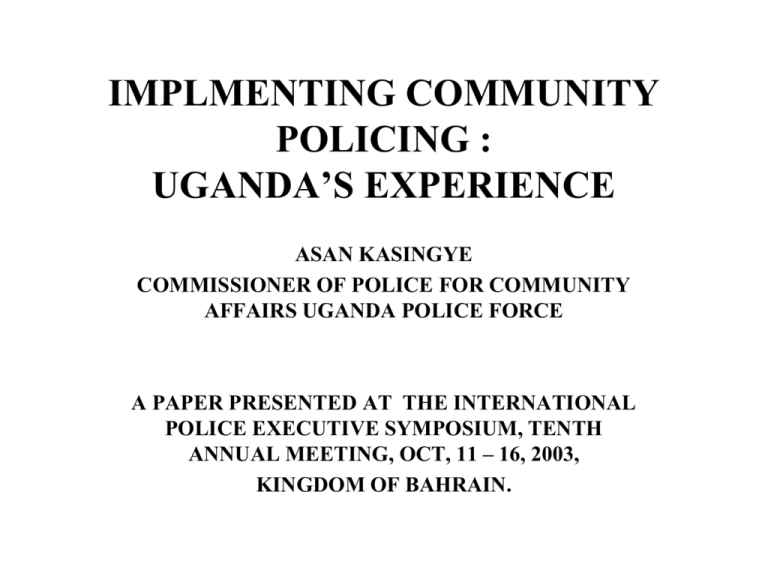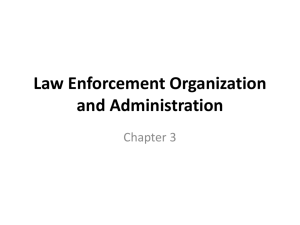IMPLMENTING COMMUNITY POLICING : UGANDA'S EXPERIENCE
advertisement

IMPLMENTING COMMUNITY POLICING : UGANDA’S EXPERIENCE ASAN KASINGYE COMMISSIONER OF POLICE FOR COMMUNITY AFFAIRS UGANDA POLICE FORCE A PAPER PRESENTED AT THE INTERNATIONAL POLICE EXECUTIVE SYMPOSIUM, TENTH ANNUAL MEETING, OCT, 11 – 16, 2003, KINGDOM OF BAHRAIN. I.1. INTRODUCTION • Brief analysis of the historical background of the police. • State of police relations. • The rationale for introduction of the community policing approach in the country’s policing system. • Highlight of challenges of implementation of community policing approach in Uganda. • Suggestion of remedial action. • Paper is based on the findings of my study entitled “Implementation of community policing in Uganda: A case study of Kampala and Luwero districts”. • Experience gained as head of the department responsible for community policing in Uganda police. 1.2 Brief Background of Uganda Police Force • • • • Department in the Ministry of Internal affairs headed by the Inspector General of Police (IGP). It is established under Article 212 of the Constitution of Uganda. Its major functions include protection of life and property and prevention and detection of crime. The police force in Uganda was introduced by the colonial government in 1906. • • • To ensure maximum expropriation of the colony’s resources for the benefit of the British, the police was used as an instrument of oppression and not as a service to the public. The post – colonial police force has largely remained accountable and answerable to the state rather than to the public. Trend of events in Uganda since 1966 – 1986. a) Political turmoil and illegitimate or unpopular governments. b) The political and civil stife crippled government’s ability to combat crime and maintain law and order. c) Poor economic prospects and massive unemployment provided motivation for the people to commit crimes. (d) The decay of government machinery and degeneration of public morals crippled the institutions and process of social control. (e) The capacity of the Uganda police to deal decisvely with this level of crime has been inadequate in terms of logistics and trained manpower. In 1986 the need to involve communities in combating crime became more prominent. To win back the trust and confidence of the members of the public in their police force and forge a partnership with them to fight crime, a more pro – active approach to pocing known as çommunity policing’was initiated in 1989. • The programme was then re – invigorated in 1993 on a national scale with the following objectives:a) To establish an effective and efficient policing system with the assistance of the public to prevent crime. b) To sensitise the communities on crime and its control. c) To promote open and honest relations between the police and the public. d) To enhance greater accountability in policing to members of the public. e) To ensure that policing priorities tally with community or local security needs f) To help promote and foster respect for human rights by the police. g) To improve the quality of police services and integrate them into community life. 1.3 Statement of the problem • There seems to be little impact on the ground. • The public, local communities and police seem to be relactant in embracing the policy. • The crime rate has remained high or even growing. • Big outcry of corruption by the public against the police. • Problem with the image of the police. 1.4 Concept of community policing • In terms of elimination, suppression, and prevention of crime in society, the two are synonymous and reinforcing . • Singh, J. (2000: 127) “crime is a community problem created by societal issues, dynamics and failures, and not just a police issue or an indication of its effectiveness. Police effectiveness and public order can not be greatly enhanced unless the community can be persuaded to do more for itself”. • It creates new roles for residents to become involved in securing safe neighbourhoods. (Skogan, et. Al. 2000: 7). • Malcolm, (1998: 1) “the concept of community policing envisages a police department striving for an absence of crime and disorder and concerned with, and sensitive to, the quality of life in the community. It perceives the communty as an agent and partner in promoting security rather than as a passive audience. • Bayley (1994 a) and cited in (Gianakis and Davis, 1998; 486) identified the basic elements of community policing as; “ Consultation with community groups regarding their security needs; command devolution so that those closest to the community can determine how best to respond to those needs; mobilisation of agencies other than the police to assist in addressing those needs; and remedying the conditions that generate crime and insecurity through focused problem solving”. • Way of policing, whereby the people in an area and the local police act together to prevent crime and disorder, Collin (1992:46). • Community policing therefore, focuses attention on police partnership with the communities it serves. Its intention is to produce a cooperate process of identifying police priorities and to provide a more efficient method of chieving results by a joint effort of the police and the communities it serves. The community should however, be at the center of this process. • 1.5 • 1.5.1 • 1.5.2 • 1.5.3 Special challenges to the implementation of community policing in Uganda Conceptualisation of community policing in Uganda: Danger of mis – understanding the concept. Design of community Policing: Wrong options Management of Community Policing Programme. • 1.5.4 • 1.5.5 • 1.5.6 • 1.5.7 General Training and Involvement of the Police personnel in Community Policing: Challenge of changing a culture of resistance and sabotage Recruitment and Trainng of CLOs: A challenge to sustainability. Deployment / Placement of CLOs Status of CLOs: A sure morale booster • 1.5.8 The Role of Government and Volunteers in the Community Policing Programme: A case of persistent mistrust. • 1.5.9 Image of the Police and Nature of Relations that exist between the Police and Public: A case of resistance and suspicion. • 1.5 Conclusion • While community policing is a very important programme in law enforcement and restoration of order in society, its impact is slow. 1.6 Recommendations • The community policing model should not only be viewed from a police centered approach but also from that of the community. • The police must integrate community policing training in its general training programme • The police service must find ways of improving its image and customer care through aggressive marketing of its programmes • Clos should be carefully selected in skills of how to handle people. • Trained CLOs should not be frequently transfered. • There is need to recruit carefully selected community policng volunteers from the communities and train them in community policing. • While community policing involves greater partnerships between police and communities they serve, there is definitely need for political support • Management and good policies such as human resource management and development are vital for proper implementation of community policing. .....................END.....................







